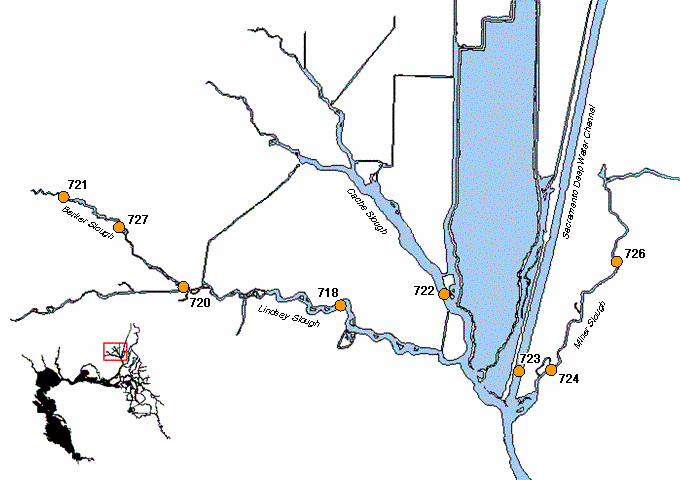Monitoring Program
 Map of North Bay Aqueduct Larval Fish Survey sampling sites (click to enlarge)
Map of North Bay Aqueduct Larval Fish Survey sampling sites (click to enlarge)
Purpose
This study is used to monitor the abundance and distribution of larval delta smelt in Barker and Lindsey Sloughs, areas which are thought to be used for spawning by these fish. The study is also used to estimate and evaluate the losses of larval fish (<20 mm) to entrainment by the North Bay Aqueduct (NBA) intake in the Sacramento-San Joaquin Delta. The presence of delta smelt larvae in Barker slough is a criterion for restrictions on NBA pumping. The 1995 Delta Smelt Biological Opinion mandates monitoring at the three Barker Slough sites for the presence of delta smelt less than 20 mm TL.We are attempting to report larval delta smelt densities in Barker Slough and the surrounding areas on a "recent-time" basis. We will attempt to post the delta smelt information on the web within 72 hours of sampling so that interested parties may use this information for water management decisions. See North Bay Aqueduct exports from the Barker Slough Pumping Plant for the last 30 days (CDWR).
Methods
Egg and larval samples are collected every other day at 4 stations in Barker and Lindsey Sloughs. Samples are collected using an egg and larval, rigid opening net constructed of 0.505 mm Nitex mesh. A single 10-minute stepped-oblique (bottom to top) tow is made at each station. The sample is preserved in formalin and then all fish larvae are sorted out and identified in the lab (this is an extremely time consuming process).
For purposes of regulating exports at NBA the "presence" of delta smelt is defined as a weighted mean of the actual catch at the three stations in Barker Slough of greater than one. The "weight" assigned to each station is dependent on its proximity to the NBA intake. Station 721 has a 50% weighting, 727 has a 30% weighting and station 720 has a 20% weighting. As stated in the 1995 Delta Smelt Biological Opinion, the diversions at NBA will be restricted to a 5 day running average of 65 cfs for 5 days when delta smelt are present. In mathematical terms, the NBA restrictions are in place when the following equation is true:
0.5*(Catch at 721) + 0.3*(Catch at 727) + 0.2*(Catch at 720) >= 1
An entrainment estimate is then calculated as the weighted mean density of delta smelt multiplied by the total water exported for the sampling day and the day after.
North Bay Aqueduct
The North Bay Aqueduct (NBA), located at Barker Slough, is used by the State Water Project (SWP) to provide water for municipal and industrial uses in Napa and Solano Counties. Pumping from Barker Slough began in 1988 and the maximum pumping capacity is about 175 cfs (pipeline capacity). Daily pumping rates have ranged between 0 to near pipeline capacity. Typically, peak pumping occurs during summer (50-125 cfs) whereas lower pumping occurs during the winter (0-49 cfs). The NBA has also been used to meet salinity objectives in the western Suisun Marsh by pumping water at Barker Slough and releasing it into Green Valley Creek (via Cordelia Forebay). The augmented flow from the creek proved to be an effective means of lowering channel salinity in various sloughs in the northwest portions of the marsh. Need for such releases will be dependent upon compliance with regulatory requirements, local hydrology, and future water quality objectives.
A positive barrier fish screen at the Barker Slough intake, which satisfies the USFWS’s biological opinion criteria, prevents fish >= 25 mm from being entrained into the NBA. To address the entrainment of larval delta smelt < 20 mm at Barker Slough, CDFG began monitoring in 1995. When such monitoring indicates the presence of delta smelt larvae, pumping water from Barker Slough shall be reduced to a 5 day running average rate of 65 cfs not to exceed a 75 cfs daily average for any day, for a minimum of 5 days and when monitoring shows no delta smelt are present. See North Bay Aqueduct exports from the Barker Slough Pumping Plant for the last 30 days (CDWR).